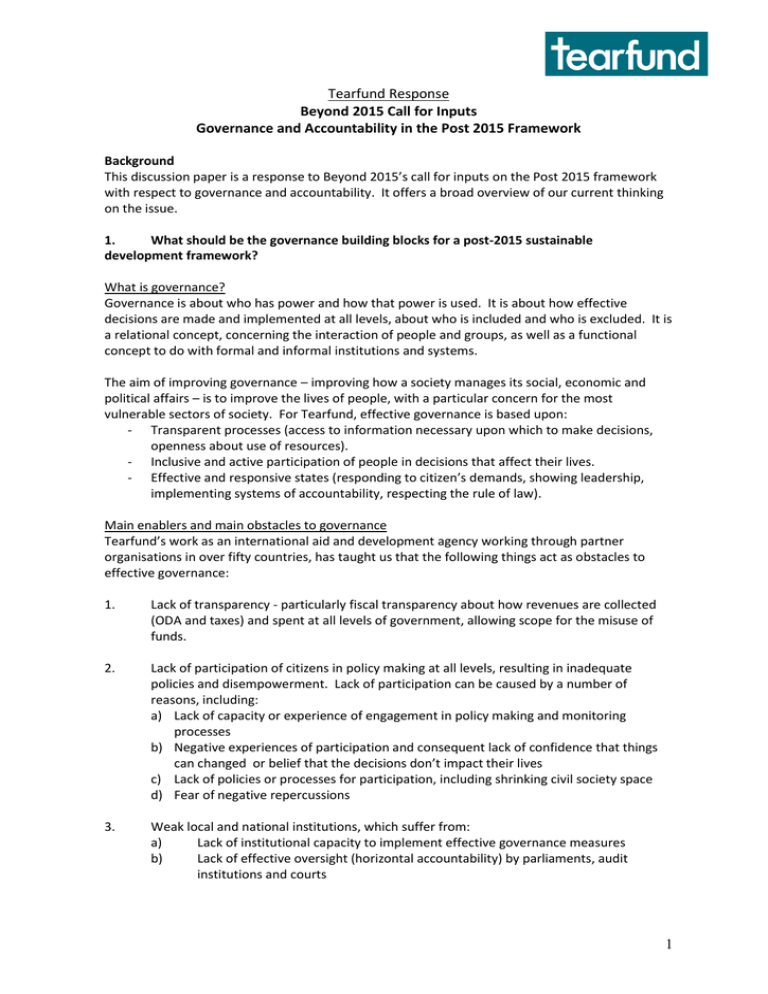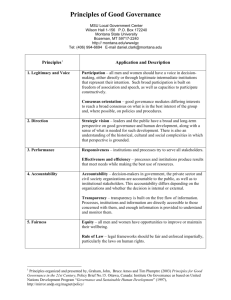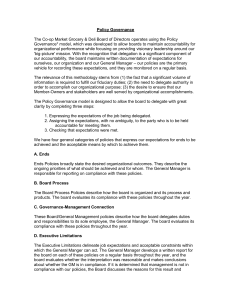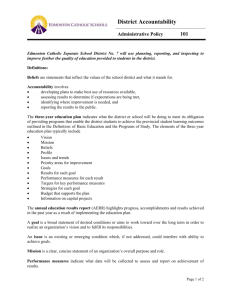Tearfund Response Beyond 2015 Call for Inputs
advertisement

Tearfund Response Beyond 2015 Call for Inputs Governance and Accountability in the Post 2015 Framework Background This discussion paper is a response to Beyond 2015’s call for inputs on the Post 2015 framework with respect to governance and accountability. It offers a broad overview of our current thinking on the issue. 1. What should be the governance building blocks for a post-2015 sustainable development framework? What is governance? Governance is about who has power and how that power is used. It is about how effective decisions are made and implemented at all levels, about who is included and who is excluded. It is a relational concept, concerning the interaction of people and groups, as well as a functional concept to do with formal and informal institutions and systems. The aim of improving governance – improving how a society manages its social, economic and political affairs – is to improve the lives of people, with a particular concern for the most vulnerable sectors of society. For Tearfund, effective governance is based upon: - Transparent processes (access to information necessary upon which to make decisions, openness about use of resources). - Inclusive and active participation of people in decisions that affect their lives. - Effective and responsive states (responding to citizen’s demands, showing leadership, implementing systems of accountability, respecting the rule of law). Main enablers and main obstacles to governance Tearfund’s work as an international aid and development agency working through partner organisations in over fifty countries, has taught us that the following things act as obstacles to effective governance: 1. Lack of transparency - particularly fiscal transparency about how revenues are collected (ODA and taxes) and spent at all levels of government, allowing scope for the misuse of funds. 2. Lack of participation of citizens in policy making at all levels, resulting in inadequate policies and disempowerment. Lack of participation can be caused by a number of reasons, including: a) Lack of capacity or experience of engagement in policy making and monitoring processes b) Negative experiences of participation and consequent lack of confidence that things can changed or belief that the decisions don’t impact their lives c) Lack of policies or processes for participation, including shrinking civil society space d) Fear of negative repercussions 3. Weak local and national institutions, which suffer from: a) Lack of institutional capacity to implement effective governance measures b) Lack of effective oversight (horizontal accountability) by parliaments, audit institutions and courts 1 b) c) Poorly designed policies, programmes and projects resulting in expenditure that isn’t effectively targeted towards the priority development issues lack of political will and institutional priority to strengthen governance The changing nature of global governance is also resulting in new and emerging challenges. In particular, the state, traditionally the focus of governance, can no longer be considered as the only actor, as power relations have been transformed and power is now shared between national, regional and global authorities, as well as large global companies. Global TNCs have increasing influence on the governments where they are registered or operating, for example over taxation, environmental or social policies, as well as legal issues. Despite these challenges, governance has been enabled through: - Increasing transparency and civil society participation in decision making processes - Increasing fiscal transparency – both revenue and budget transparency - Active citizens – including an active civil society, enhancing participation and vertical accountability - Independent and effective institutions of oversight, including parliaments, audit institutions and courts - Increased corporate transparency and accountability - Strengthening of the rule of law - An independent media Governance and the MDGs There has been widespread recognition that governance is one of the missing links in the achievement and sustainability of the MDGs.1 At the MDG Summit in 2010, world leaders acknowledged that good governance at the national and international level is essential for sustained, inclusive and equitable growth and the eradication of poverty and hunger. Yet there are challenges with including governance as an integral part of a global framework – including it being a politically sensitive issue and the fact that governance in and of itself is hard to measure. And this was one of the reasons for it not being included in MDG 8 for Global Partnerships and that the relationship between power and poverty was not given the full attention it deserved. But this needs to change in the post-2015 agenda – it should no longer be regarded as ‘the missing link’. Governance and the post-2015 agenda As we move forward to a post-2015 framework, governance must be seen as an integral part of the overarching framework. Governance issues need to be addressed on a number of levels – from the very local to the global. Without an effective governance framework, addressing development issues such as access to water and sanitation, climate change and food security will not be possible. Consequently, Tearfund believes that the principles of governance - transparency, active and inclusive participation, and effective and responsive states, should be at the heart of a post-2015 agenda going forward. These 3 broad principles should underpin the overall global vision for the post-2015 framework, as well as help formulate a specific governance goal and any respective governance targets and indicators for national policy making. 1 See, for example UNDP (2010) The Path to Achieving the MDGs: a synthesis of evidence from around the world; UNDP (201) Beyond the Mid-point: achieving the MDGs. 2 What should practically be integrated into a new development framework? As a broad narrative One of the benefits of global instruments like the MDGs is that it sets out a broad vision for a fairer future. It enables states to agree in principle to do something and provides a political mandate, common language and moral framework for a forthcoming development agenda. As mentioned above, principles of transparency, active participation and effective and responsive states are all essential components of an effective governance narrative (or what Tearfund has referred to as ‘governance for human flourishing’).2 We therefore believe that these governance elements should underpin an overall post-2015 narrative and that any new goals (whether sectoral or otherwise) should promote these principles. Why a specific goal? In many regards, the MDGs framed the development agenda for over a decade and brought increased emphasis and priority to certain thematic areas – which the specific goals determined. This is why Tearfund believes that governance, as the current missing link in the MDG agenda, needs to be included as a distinct goal in the post-2015 framework. This will ensure that it is given the priority needed, that progress is measured and for there to be both state-to-state accountability on the issue, alongside vertical and horizontal accountability. What could a goal or target look like and how would it be measured? Any overarching governance goal should be broad in scope and universal, requiring progress by all states (not just developing country governments) whilst recognising that the steps forward will vary in each context. Any goal would need to be positive in its language and measure proactive measures by states, rather than violations. This will help create an environment where there is a race to the top and enable progress to be made in the context of some of the politically sensitive issues involved. Any governance goal and indicators should rest on the principles transparency, active participation and effective and responsive states, and indicators should attempt to measure positive progress on each. Where possible, these goals should be linked to existing global norms and databases that track such progress, such as the Open Budget Index3 or the World Governance indicators4. This would allow clear guidance on the content of the goals, as well as clarity and comparability in measurement. On transparency, the goal should be related to the type of information that is available, whether proactively offered by government through open data initiatives, or available through citizen requests. Some examples could include: - Freedom of Information legislation 2 http://tilz.tearfund.org/webdocs/Tilz/Research/04_Gordon_Governance_HumanFlourishing.pdf http://internationalbudget.org/what-we-do/open-budget-survey/ 4 The Worldwide Governance Indicators (WGI) are a research dataset summarizing the views on the quality of governance provided by a large number of enterprise, citizen and expert survey respondents in industrial and developing countries. These data are gathered from a number of survey institutes, think tanks, non-governmental organizations, international organizations, and private sector firms. The WGI are composite governance indicators based on 30 underlying data sources. http://info.worldbank.org/governance/wgi/index.asp Voice and accountability indicator captures perceptions of the extent to which a country's citizens are able to participate in selecting their government, as well as freedom of expression, freedom of association, and a free media. Government effectiveness captures perceptions of the quality of public services, the quality of the civil service and the degree of its independence from political pressures, the quality of policy formulation and implementation, and the credibility of the government's commitment to such policies. 3 3 - Progress on fiscal transparency e.g. the publication of key financial data on government revenues on aid, tax and investment as well as expenditure. This can be measured through the OBI. On participation, the goal should include the establishment of clear guidelines and processes for citizen participation in policy formulation and implementation, as well as the ability for citizens to participate in selecting their government; laws, policies as well as public perception in terms of freedom of expression, freedom of association, and a free media. The indicators would draw on the existence of relevant legislation and its implementation, as well as the existence and effectiveness of participative policy processes. The Worldwide Governance indicators Voice and Accountability Indicator is a useful place to start, but has limitations in that it focuses on perceptions. For effective and responsive states, the goal would need to aim towards strong and effective institutions, effective oversight bodies, political commitment and resources to improve governance. The indicators could measure a mixture of the existence and resourcing of oversight bodies, existence of relevant policies as well as public perceptions of the effectiveness of the government, including perceptions of corruption. Again, the Worldwide Governance Indicator Government Effectiveness Scoring could be one place to start, as could Transparency International’s Perceptions of Corruption Index, although both of these are based on perceptions. It is important that a governance goal is not seen as stand-alone, and that the specific targets link with other initiatives. For example, targets could also include all member states signing up to major international initiatives, such as the Open Government Partnership, or Conventions such as the United Nations Convention Against Corruption. 2. How can the post-2015 sustainable development framework be designed so that it ensures real, meaningful accountability at the country and global levels, in line with government’s existing human rights, development and environmental commitments? Lessons from the MDGs The MDGs have demonstrated challenges of accountability, and there is often a reference to the ‘accountability gap’. Lessons include: - Lack of clarity as to who was responsible for achieving the MDGs, therefore preventing citizens from demanding accountability. - Lack of information at the community level – accountability starts at this level, yet the MDGs were often not communicated down to citizens, therefore preventing them from calling for change. - The ‘implementation gap’ due to states being able to sign up to the agreement, but with few negative consequences if they are not achieved. - Too much of a focus on developing countries responsibilities – therefore not fully recognising the inter-connectedness of the MDGs and developed countries contribution. That said, the MDGs were helpful in: - Providing citizens and civil society with a useful set of data with which to observe development trends - When communicated to the local level, the MDGs were a useful advocacy tool for local communities to call for change. It is also at this level where change was most significant. 4 Zambia example In Ndola District Zambia, Tearfund partners Micah Challenge Zambia and the Jubilee Centre informed communities of the state’s commitments to the MDGs. This inspired Mapalo community to look at how the MDGs can be achieved in their local area. The community drew their vision for 2015 on a church building and then advocated for change in particular areas by inviting local councillors and the Member of Parliament to address the community on several occasions. Following this ongoing advocacy, a new clinic has been built, alongside a new road and local court in the community. Accountability in the post-2015 agenda The issue of accountability is essential to be addressed if the post 2015 goals are to have any chance of being successful. Below we offer some initial ideas of what would need to be included in any accountability framework. - The broad goals and specific targets and indicators should be useful for a number of institutions and bodies. They should be useful for vertical accountability (i.e. citizens to state), alongside facilitating horizontal accountability (i.e. useful for Parliaments, audit institutions and courts). They should also be useful for state-to-state accountability and regional bodies should play a part in encouraging other state’s progress.5 There should be a clear pre-agreed mandate between the executive and different oversight bodies to scrutinise state progress on the goals. - It should be very clear who is responsible for fulfilling the goals. The primary responsibility should rest on the nation state, but will also include non-state actors. State bodies should be required to outline how they will fulfil the goals at both national and local level (e.g. district level). This will therefore allow communities to monitor and track progress, and advocate for changes at the local level. - Civil society participation at every stage in the development, implementation and monitoring of the goals is essential. If goals are to be adapted for different national and local contexts, civil society participation in developing any country-specific goals, indicators and plans is essential. It is an opportunity to put into practice new models of open and participate policy-making that will result in greater citizen ownership and more effective policies and actions. - National and local commitments should be widely publicised – including at the community level. Posting information in public places e.g. outside schools or online, enables communities to know the commitments that have been made. In addition information must be presented in a meaningful and comprehensive format so that citizens feel empowered to make informed decisions in order to hold their leaders to account - The capacity of states to fulfil their commitments should be considered in the goals – capacity will vary and therefore targets should be specific to the context, whilst demonstrating progress towards the overarching goals. Mechanisms to support states to fulfil their commitments should be put in considered. For instance in some states this may require investing in civil service institutions through recruitment, training etc so that they are better equipped to deliver on targets set. 5 The role of regional bodies is significant, particularly in the global South as these forums have had some degree of success in influencing decision making and can improve performance in meeting targets. 5 - A clear independent UN Review mechanism should be put in place and information and updates on national progress should be widely publicised and subject to Parliamentary scrutiny. This would potentially help issues of redress. Information alone is not sufficient for accountability, but in many cases, without access to information, holding governments to account is near impossible. An independent review process is essential to ensure effective monitoring. This should draw upon in-country experiences and peer-reviews by other states, and should be a transparent process. Melissa Lawson November 2012 6




